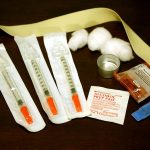Sometimes we talk about drinking too much. We complain that it’s making us fat and that the hangovers are no fun. Maybe we should cut back, but what if cutting back turns out to be really hard? What if we need help? A medication called naltrexone dampens the rewarding effects of alcohol and can help people cut back.
Time Traveling to 1988
A look at harm reduction efforts 30 years ago in light of our current opioid epidemic
Targeting the Intersection of Substance Use and Suicide
In 2015, the US death rate increased for the first time in ten years, while all-cause mortality has been increasing among young and middle-aged Whites for the past 15 years. These increases are being driven mainly by the troubling rise in deaths due to drug overdose and suicide.
The Importance of Confidentiality for Effective SBIRT Interventions for Teens
Young people aged 12 to 20 account for 11 percent of all alcohol consumed in the United States, and more than 90 percent of this consumption is binge drinking. Trust facilitates the effectiveness of SBIRT, especially among teens.
Can Medication in the ER Commence a Path to Recovery?
Figuring out how to intercept and help patients with opioid addiction in medical settings is an urgent issue. Learn about reducing unhealthy substance use in emergency settings, including the use of buprenorphine for patients with opioid addiction.
A Heroin Strategy to Integrate Public Health & Safety
The Heroin Response Strategy will create a functioning Public Health and Public Safety Network that allows real-time data sharing in 17 states
Technology Can Improve Care for Patients with Addiction. It’s Time To Take Notice.
IRETA has teamed up with the National Institute on Drug Abuse to introduce you to evidence-based addiction technology.
What Happens When the Grant Money’s Gone? Tools for SBIRT Reimbursement
A successful SBIRT program has many moving parts, one of which is the ability to bill and receive reimbursement for the services that you offer.
Gender and Sexuality in Healthcare: Identity Matters, But Labels Only Go So Far
We ask healthcare professionals to strive for cultural awareness and cultural competency. But frequently, education about gender and sexuality is simplified into the easiest letters to talk about. The most important aspect of labels is understanding what they mean to each individual.
You Can’t Fool the Bladder Police
Drug testing is an important clinical tool. What do we know about doing it well?










